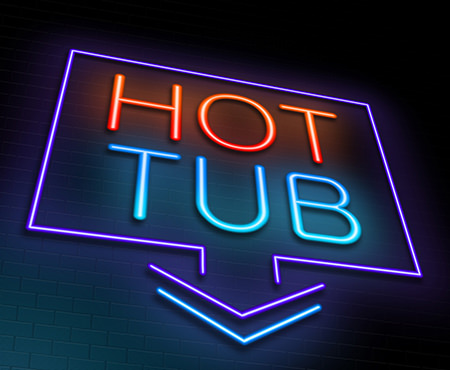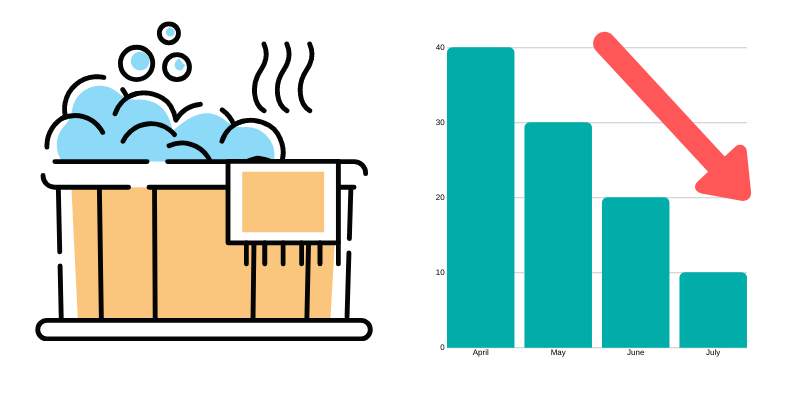
Whatever you do, paying for the energy to heat your hot tub is going to have a relatively large impact on your monthly electricity bill. In fact, throughout the lifetime of your hot tub, your energy costs could be as much or more than the outlay for the hot tub itself.
Saving money on hot tub running costs is a high priority for most hot tub owners and, with a few simple habits and changes, you too can keep costs down to a minimum.
Each of the 25 tips below will save you money on the running costs of your hot tub. Individually they will only make a small difference but if you can implement as many as possible collectively you will see an impact on your electricity bill.
1. Check the quality of your hot tub cover
If you have an old hot tub cover or your hot tub cover seems to be worn out then buying a new high-quality cover is one of the best things you can do to save on your monthly energy costs.
Bear in mind also that a number of hot tub manufacturers don’t always supply ultimately thermally efficient covers with their hot tubs because they can add considerably to the overall expense. Maybe your cover isn’t as efficient as it could be and would
Most of the heat from your hot tub will escape by rising upwards. If you have a thermally efficient hot tub cover then it will thoroughly insulate the area where most of the heat escapes from. Good quality covers are not inexpensive but they will last a number of years and over the course of their
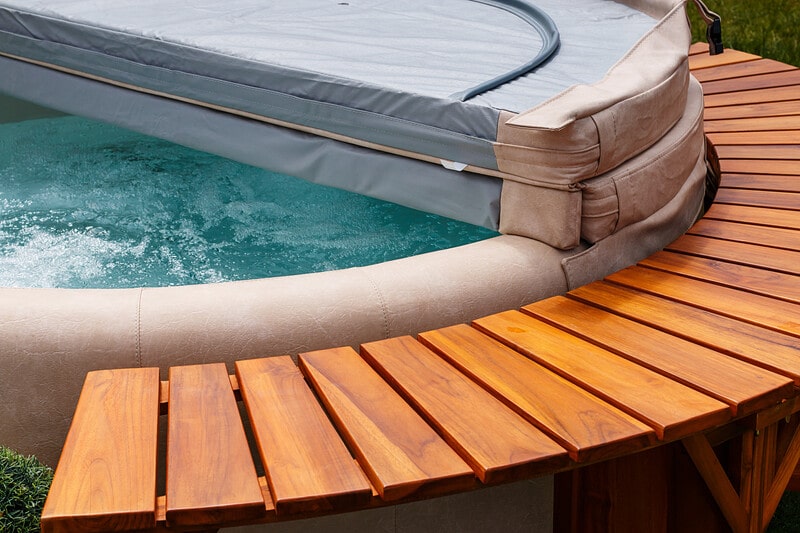
When looking for a new hot tub cover it’s really important that you measure your hot tub carefully so that you get a perfect fit. Any discrepancies or air leakage will, over the lifetime of the cover, waste a large amount of money so it’s important to get those right from the outset.
You also need to look very carefully at the thermal insulating specifications of each cover and compare their efficiency and balance out the cost outlay for each cover.
I have created a really detailed post on choosing a new hot tub cover and also measuring up for a new cover here. I hope it’s helpful!
2. Check the cover for damage
Any cracks, tears or damage to your hot tub cover will probably be leading to either heat escaping from the hot tub or cold air and water getting in.
Check carefully around joints and seams and also make sure that the hinge area is secure and in good condition. Check the weight of the cover as well. Hot tub covers have a dense foam core in the middle and inevitably, over time the core will soak up moisture from the hot tub and from the outside elements and will become waterlogged.
Once the core is waterlogged it’s thermal efficiency is severely compromised. You can tell if the core is waterlogged by assessing the weight of a hot tub cover – the heavier the cover the more potentially waterlogged and less thermally efficient it will be.
If you have found that the outer cover of your hot tub cover is damaged it might be possible to make a repair and to make it watertight again. Depending upon the brand it’s also possible that you might be able to purchase a replacement outer cover and keep the thermal core and other attachments and so save some money.
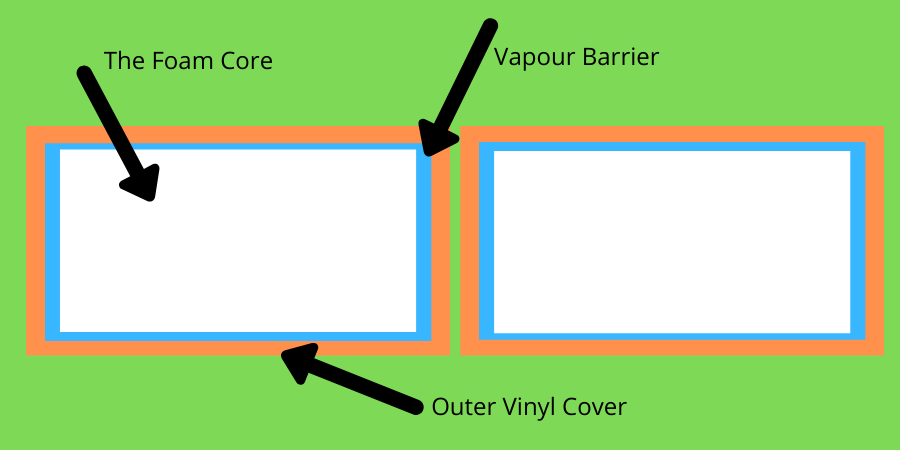
If you suspect that your foam core has become waterlogged then it might be possible to take it out and to let it dry in the sun. This isn’t possible in all types of cover and you will need to take the core out of the vapor barrier so that it can dry before replacing the barrier to prevent further moisture from entering.
You can help prevent moisture build-up and damage to your hot tub cover by checking it over weekly and repairing any small bits of damage before they get too serious.
You should also remove the cover each week completely from the hot tub, clean it and let it dry out for several hours in the sun. This will help
3. Block the prevailing wind
The prevailing wind is the direction that the wind blows in most frequently. If you don’t know which direction the prevailing wind comes from in your area you can find out by having a look at this link.
The problem with the prevailing wind is that if your hot tub isn’t protected from it, it will constantly be blowing on the hot tub and reducing the temperature.

If you think about how wind chill works you will realize that it’s not particularly helpful to have any draught or breeze blowing around something that you are trying to keep warm! The stronger the prevailing wind is, the cooler the wind chill factor and the more problematic this becomes for the hot tub.
You can go a long way towards preventing cooling via the wind chill factor by blocking the prevailing wind from your hot tub. This means erecting some sort of barrier between the direction of the prevailing wind and your hot tub. This might be a fence or wall or possibly even a natural barrier of dense planting.
Whatever type of barrier you go for it will be made even more efficient if you can include some sort of insulation between the barrier and the hot tub. For example, if you erect a fence next to the hot tub it would be a good idea to allow space for some insulation boards or something similar to be put between the two. This might not always be possible but the closer to barrier the hot tub is the better protection it will get.
4. Lower the thermostat
It stands to reason that the hotter you have the temperature of the water in your hot tub the more energy it will take to heat up. Most people like to have the temperature of the water somewhere between 36 degrees centigrade and 39 degrees centigrade and interestingly, women apparently enjoy having the water a little hotter than men do.
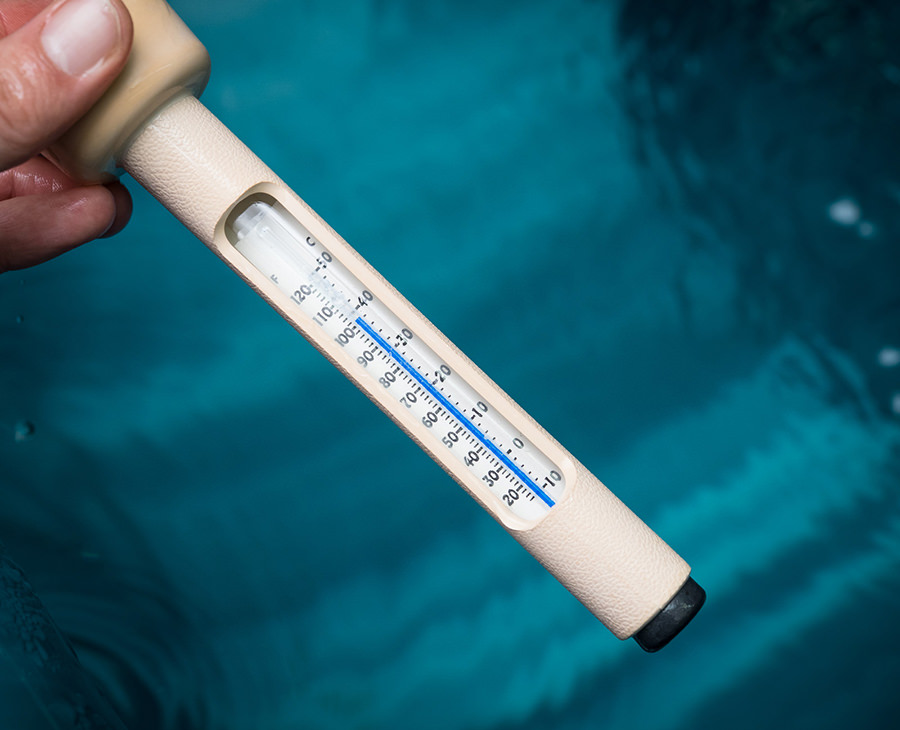
You could try lowering the temperature on the thermostat by as little as half a degree and seeing if you really notice the difference. If you don’t, and you are still perfectly happy in your hot tub, then perhaps try lowering the temperature by another half degree to see if that is noticeable as well.
Lowering the temperature by 1 degree or even buy half a degree will probably be barely noticeable to you when you’re in the water but, over a period of time this will make a saving in your energy bill.
It’s also a good idea to think carefully about the pattern of usage that your hot tub gets. Generally speaking, it’s more economical to keep your hot tub switched on all the time with the water at working temperature. This works well if you use your hot tub frequently and enjoy spontaneously having it available for use every day.
However, if you really analyze your usage over a few weeks you might realize that you only use your hot tub maybe towards the latter part of the week or only at the weekend. If you lower the temperature by a few degrees during the days that you are not using the hot tub and then raise the temperature the day before you know that you’re going to use the hot tub you could make a considerable saving on your energy bill.
This might take some trial and error as it will depend on the efficiency of your hot tub as to whether any saving is made. You also need to reliably have a block of time during the week when the hot tub isn’t in use when you can lower the temperature. If your usage pattern doesn’t fit with this then it’s probably more economical to keep the hot tub switched on and at working temperature all the time.
If you want a particularly accurate way to continuously monitor your hot tub’s temperature then check out this floating thermometer and wireless display on Amazon.
5. Clean your filter
A dirty filter uses more energy as the pump has to work much harder to draw water through it. You should be cleaning your filter on a weekly basis and giving it a thorough, deep chemical clean every 3 months or so.
Make sure that you replace the filter on a yearly basis or according to the manufacturer’s instructions. If you have an inflatable hot tub you will probably find that you need to clean the filter more frequently. Don’t skimp on your filter maintenance as it will cost you money and add to your monthly electricity bill.
There is a good selection of replacement filters on Amazon here.
6. Keep the water in the tub
You and your kids may well enjoy having water fights and splashing each other in your hot tub but bear in mind that all of that water that is being splashed out will need replacing.

The chances are that you replace the water with cold water and of course, it takes energy to bring that cold water back up to the hot tub’s operating temperature. It seems a bit miserable to recommend not splashing about and having fun in your hot tub but, if you can keep as much water in it as possible, it will save you money!
You could, of course, replace the water with hot water from the tap. I guess this could theoretically be more economical but you will have had to have heated this water up as well! The main issue with using hot water from the tap is that you won’t have been able to filter it like you can do when you fill from the hose and use a filter attachment.
The hot tap water may possibly have excess metals and calcium in it which could
7. Use a thermal blanket
Thermal blankets can be cut to the exact shape of your hot tub so that they are a snug fit and won’t allow any warm air to escape. Basically, they contain hundreds of tiny insulating air bubbles that allow the blanket to float on top of the water and create the insulating properties.
Once you’re finished using your hot tub, place the thermal blanket on top of the water where it will happily float and then put the main cover on top as well. Thermal blankets are relatively inexpensive and easy to use and over time will save you a great deal in energy costs.
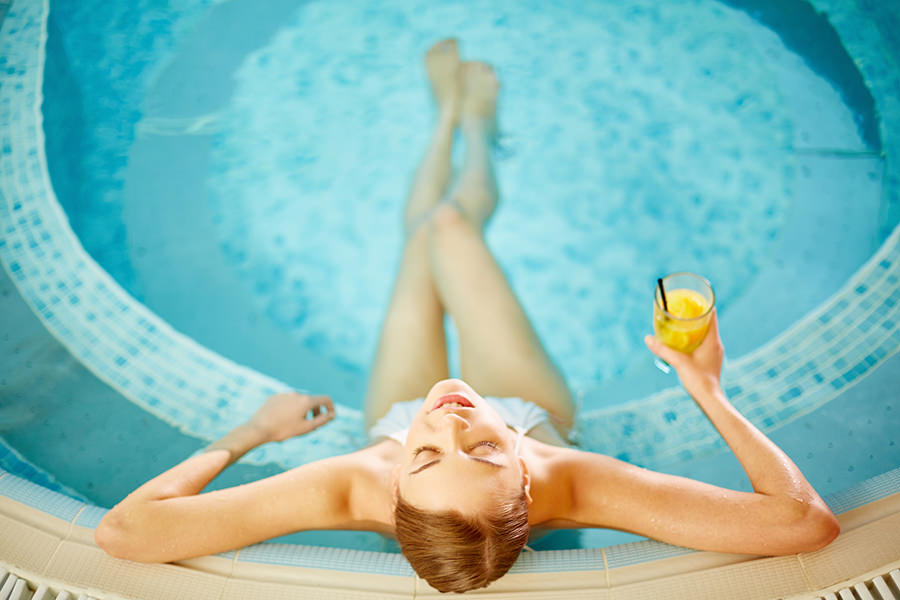
8. Keep your water clean
You should be following a regular program of routine water maintenance anyway, but it’s also important to keep your water clean to keep your energy bills down. Dirty water has a higher proportion of floating debris and particles in it that make the water more difficult to move around and also to draw through the filters. This means the pump has to work harder and uses more energy in the process.
Keeping your water clean starts with making sure that you have the correct alkalinity and pH levels in your hot tub. Check this with test strips and use balancing chemicals as needed.
You also need to check that you have the right level of sanitizer in the water and the water will need shocking on a regular basis. If you suspect that your water is becoming cloudy or dirty or is ready for change you can check the level of total dissolved solids or TDS in the water.

If the TDS level is anywhere near 1500 parts per million then the water is saturated with particles of dirt and debris. Not only is this a potential health risk, but also will mean that the hot tub is having to work significantly harder to move all that sludgy water around.
Click here for my ultimate guide to hot tub maintenance.
9. Check the energy usage of built in lights
A lot of hot tubs have built-in lighting systems. You probably don’t even think about the
In the first instance check to see if it’s possible to use the hot tub with the lights
It might be a bit more difficult to check on the type of bulbs that the lighting uses and you might have to wait until you drain the hot tub to do this. However, it’s worth having a look to see if it’s possible to use any lower energy LEDs or bulbs than are currently in the hot tub.

If you are in any doubt about the inbuilt lighting system then you could just completely switch it off and maybe change to a more modern possibly battery-operated system. These are relatively cheap to buy and much more energy efficient.
10. Close the jets when not in use
Try to get in the habit of closing the jets when your hot tub isn’t in use. When the jets are open cold air is sucked into the system and then through into the water. Obviously, if cold air is being blown through the water then this is actually quite efficient at lowering the temperature of the water and so your hot tub has to work harder to keep the temperature up.
11. Get a new hot tub
This is obviously a rather drastic step but, if you have a relatively old hot tub it will almost certainly be very inefficient in terms of its energy consumption in comparison to a modern hot tub. It’s possible that you will completely slash your monthly energy bill by upgrading to a new hot tub.
I have read instances of people spending $100 or more per month on their energy for the hot tub with older less efficient hot tubs. They have then upgraded to a modern, energy-efficient model and their energy bill has f
Clearly, purchasing a new hot tub is a major expense but, if you did experience the savings above and you kept your hot tub on all year round you would, in theory at least, save around $840 per month in energy.
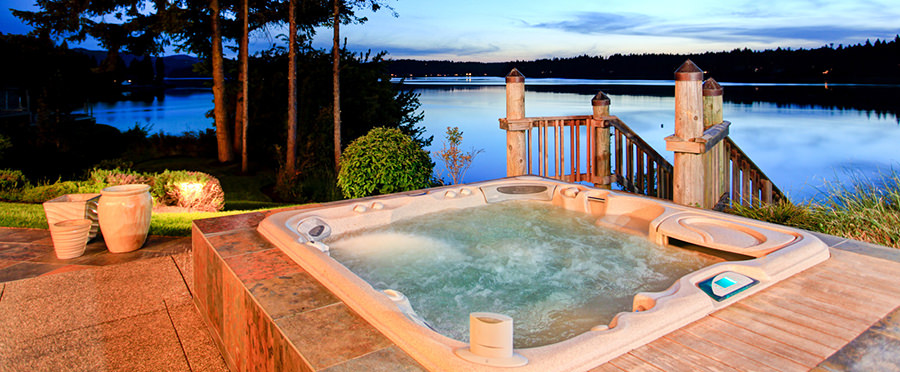
If you multiply this by the expected life expectancy of a good quality hot tub of around 10 years or more then you are looking at
If you are considering purchasing a new hot tub to save on your monthly energy bill then it’s vital that you do your research and carefully read the specifications and expected energy usage of the new hot tubs that you are interested in.
You will also need to have an accurate idea of how much your current hot tub is using per month in electricity as well. Having a smart meter is a great idea and will make this easier to calculate. Once you have a figure for both the expected usage of the new hot tub and also for the usage of the hot tub you currently own you can then do a comparison and work out the long-term cost savings in relation to the cost of purchasing a completely new hot tub.
12. Change energy supplier
Many people simply choose an energy supplier and just stick with them for years out of habit. You can potentially save yourself a great deal of money by regularly shopping around for your energy to see if there are any better deals.
It’s worth looking on comparison websites on a yearly basis or so to see if it’s possible to get your electricity more cheaply elsewhere. In order to do this accurately, you will need some past electricity bills or you will need to know your exact usage so that you can calculate the saving and see if it’s worth changing.

Even if actually changing seems like too much hassle it can be worth contacting your current supplier and saying that you have found a like-for-like deal elsewhere and asking if can they possibly match it.
13. Use off peak electricity
Check to see if it’s possible for you to use off-peak electricity to heat your hot tub. Often electricity can be supplied more cheaply overnight and, if this is the case, you could possibly set your hot tub to do most of
If you don’t already have the option of using off-peak electricity it might be that you will need to get a new electricity meter and depending upon your supplier there could be a setup and installation charge. If this is the case you will need to calculate your expected savings if you do change to off-peak electricity and
14. Turn your hot tub off when you are away
If you know that your hot tub isn’t going to be used for a week or so then you will save money by actually switching it off and letting it cool down. This isn’t worth doing if it’s not going to be used for only a few days as it’s relatively expensive to actually reheat the water from cold up to the required temperature. However, the magic number seems to be around 7 days or so and at this
If you regularly go away or don’t use your hot tub for around 7 days it would be worth trying to estimate how much it costs to keep the hot tub on for a week whilst it’s not been used and comparing that with the cost of switching off and then paying for a major reheat.
Depending on the thermal efficiency of your hot tub you might find that it’s not worth switching it off unless you’re going to be away for 10 days or even a fortnight and it might simply be more cost-effective to leave it on all the time possibly at a slightly lower temperature.
Other hot tubs might be more efficient if you switch them off if they aren’t going to be used for a shorter period of time than a week. It all depends on the type of hot tub and the usage it gets so it’s worth doing a few calculations to work out what’s best for yours and what is going to be most efficient.
15. Keep your hot tub on at a constant temperature
Generally speaking, a hot tub will be more efficient if you keep it on at a constant temperature. This is particularly true of more modern hot tubs that have much higher quality insulation and are much more thermally efficient.
Think of this in a similar way as to when you are driving a car. When you are traveling at a constant speed on the freeway or motorway the engine is more efficient than when you are constantly braking, stopping, starting and accelerating.

The hot tub is similar in that if all the heater has to do is to periodically top up the heat to keep it constant it will be more efficient than if it is having to work hard to heat up cold water over and over again.
16. Add extra insulation into the cabinet
Have a look inside your hot tub cabinet. Is there anywhere where you think it would be possible to add extra insulation? Essentially, the more insulation there is inside the cabinet the more efficient the hot tub would be in terms of keeping its heat and it will cost less to run.
If you are going to add extra insulation into a cabinet you can use spray foam or alternatively, household insulation inside large plastic bags can be stuffed into any gaps. You need to be very careful that you do not put any insulation near any air intakes or any parts that need to be accessible for maintenance so do not add any insulation to the equipment bay.

You could also consider creating a secondary cabinet or skin around your hot tub. You could fill the gap between the two cabinets with insulation and this would effectively double insulate the whole of the hot tub. You might be concerned that this may not look particularly aesthetically pleasing but you could consider double skinning the cabinet around just the sides or the back so that it is less noticeable.
17. Use an all-weather cover in winter
All-weather hot tub covers are relatively inexpensive and go over the main thermal cover and cover the whole hot tub and cabinet as well. They don’t have any insulating properties particularly but they will prevent rainwater from getting onto the hot tub and most importantly will keep the whole hot tub draught proof. Keeping out the howling winter winds will help to keep the hot tub warm and save on your heating bill.
18. Don’t buy a second hand hot tub
It can be tempting, when you’re looking at the price of new hot tubs, to go for a second-hand hot tub in the hope of saving some money. This might seem like a good idea at the outset because the initial outlay will probably be significantly less.
However, in the long term, a second-hand hot tub or an older hot tub will most probably use significantly more energy per month to run than a new more thermally efficient modern model.
That’s not to say that some second hand or reconditioned hot tubs on not good value for money. You may well get an absolute bargain but if you are looking for the ultimate in monthly energy efficiency then you are probably better putting your money into a brand new hot tub.
If however, you know that you won’t use your hot tub all year round or that there will be significant periods when the hot tub is switched off, then going down the second-hand route may well be a fantastic plan.
19. Place the hot tub on insulating boards
A surprising amount of heat can be lost through the bottom of your hot tub if it’s standing on, say for example a stone terrace. It might be too late to do anything about it if you have a fixed hot tub but, if you have an inflatable hot tub then standing it on some insulating boards is a good way of making it more thermally efficient.
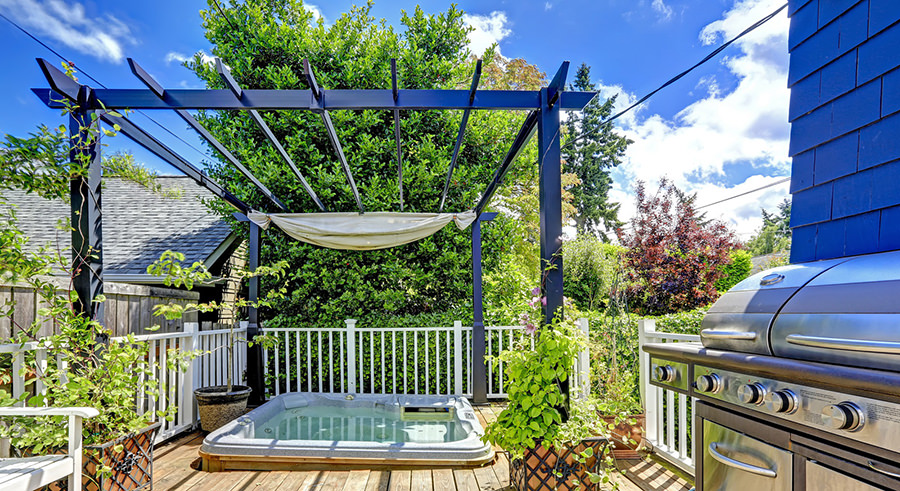
20. Put your hot tub in gazebo or an outdoor building
Anything that protects your hot tub from the elements will help with making it more energy-efficient. You will be preventing cooling winds, rain
However, the more enclosed your hot tub is, the more issues you will have with condensation and ventilation will become a prime consideration. In many
Again, you will have to do a cost-benefit analysis to see whether the outlay of erecting a gazebo or outbuilding is likely to pay off in the savings you will make your energy bill over a long period of time. If you want to have a gazebo anyway then it’s certainly a good idea, but if you are thinking of
21. Position your hot tub in a south facing aspect
The actual position of your hot tub can make a big difference to how much heat it is able to retain. This will obviously depend on which hemisphere of the world you are in but, assuming that a Southerly facing aspect gets most of the daily sun, this would be the most thermally efficient place for a hot tub to be positioned.

The warmth from the sun will help all day long to keep the temperature of the water high. Conversely, if your hot tub was against a North facing wall, for example, it wouldn’t get any sun at all during the day and it would have to work much harder to keep the temperature up.
22. Drain and refill only when you really have to
Reheating your hot tub water from cold uses a lot of energy and if you do this more frequently than you have to it will have an impact on your energy bills. To get the optimum amount of time available, you need to follow a very careful water maintenance schedule to keep the water as clean for as long as possible.
However, all water will need changing at some point. The general rule is that a hot tub should be drained and refilled round about every 3 months or so but this will depend upon usage, how good you have been at maintaining the water and the efficiency of the filtration system.
You can accurately predict when your water will need changing by using a test strip to measure the TDS levels in the water. This is the amount of total dissolved solids in the water or the amount of dirt and debris. Once the TDS level reaches 1500 parts per million it’s time to change the water.
23. Fix any leaks inside the cabinet
It’s worth periodically checking inside the cabinet for water leaks. Obviously, it’s not a great idea to have a leaking hot tub anyway but if the water leaks into the insulation it will make it less thermally efficient. You can have a look at my blog post here about fixing water leaks in your hot tub for help.
24. Make sure cover is firmly closed
It’s so easy, at the end of a relaxing hot tub session, to either forget to put the cover back on or to just quickly put it down without fastening it and checking that it is firmly closed.
Bearing in mind that it may be several hours or even a couple of days before you look at it again, if the hot tub cover isn’t on the hot tub properly you will be allowing valuable heat to escape for a long time. It’s always worth having a quick check each day to make sure that the cover is firmly attached and no warmth is escaping.
25. Save electricity around your home
Finally, this isn’t strictly hot tub related, but it makes sense if you are finding that your electricity charge is high to try to cut back on your usage around the home as well. Your hot tub, even if it’s working very thermally efficiently, will use a good proportion of your monthly electricity but you will probably be able to make savings around the house as well by just making a few small changes. Have a look at this post here and see where you could be saving money.
I hope that this post has given you some good
I hope it goes well and good luck!

